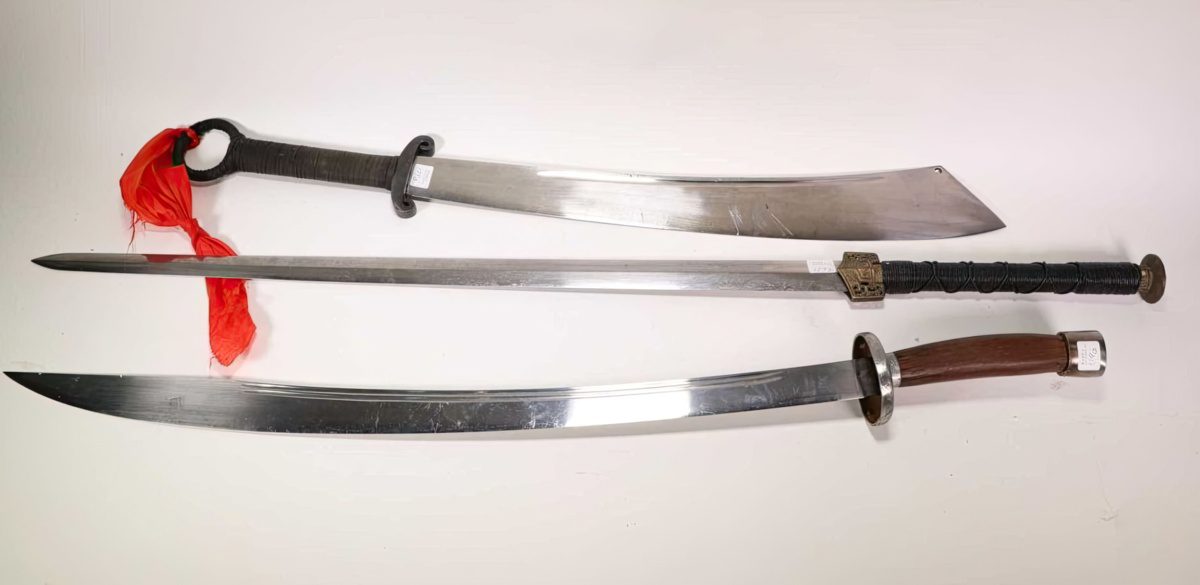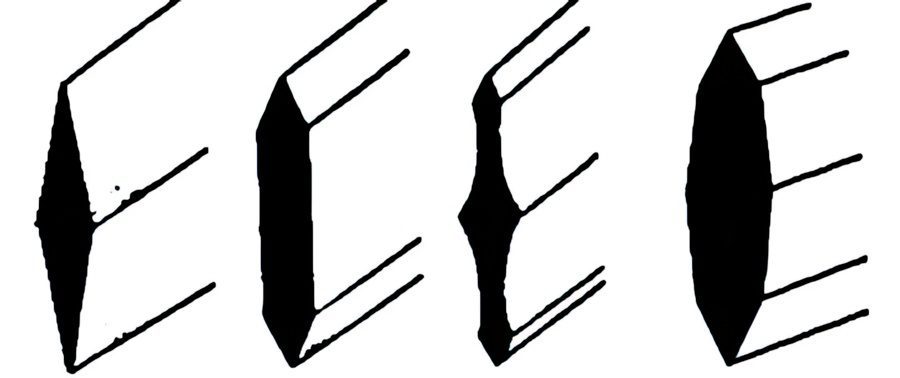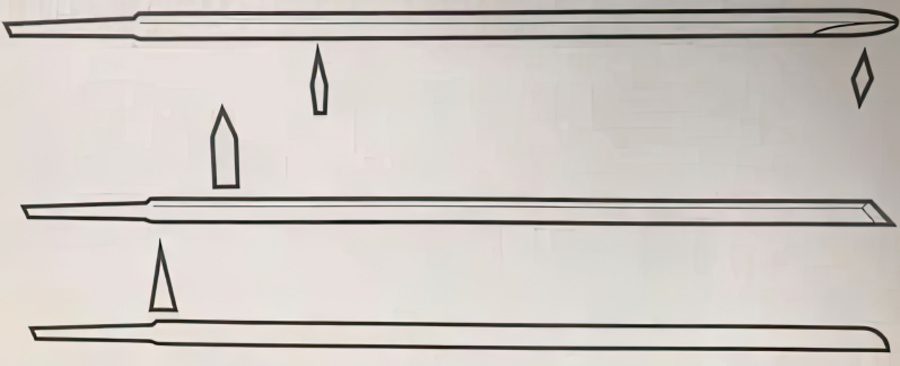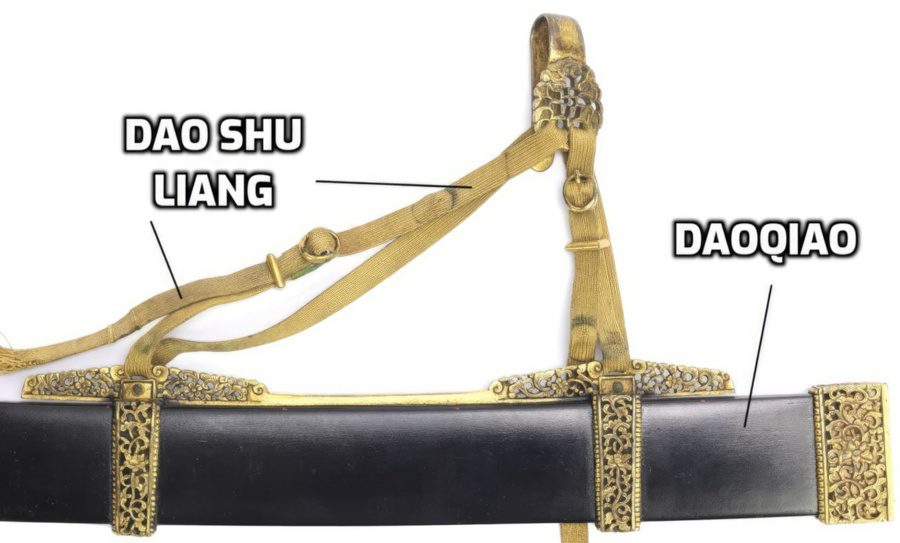Parts of a Chinese Sword: The Jian and Dao Anatomy

What’s in this article?
Chinese swords are very beautiful and dangerous weapons that have played an important role in Chinese history and culture for thousands of years. Their intricate design and construction are a testament to centuries of Chinese swordmaking tradition.
One must be familiar with the complex workings of Chinese swords to fully appreciate their lethality and beauty and use them more effectively in Wushu or Kung Fu Chinese martial arts. In this article, we’ll introduce you to the various components of the Dao or Jian, the traditional Chinese swords, and their use.
Parts of the Jian Sword

The Jian is a type of ancient Chinese straight, double-edged sword that has been valued for over a thousand years. Its blade is long and narrow, while the handle is straight and slim. Soldiers, martial artists, and academics employed the sword in ancient China and surrounding regions. Together with the staff, spear, and Dao swords, it is one of the four key weapons in Chinese martial arts.
1. Jiantan – Pommel
The Chinese word for the pommel of a Jian sword is Jiantan, and it is there that the sword begins. It’s a metal weight at the end of the handle, and its purpose is to balance the blade so the user can have a firm hold. First only available in ring pommels, Jian pommels eventually evolved into more complex designs like the metal cap, ball, or teardrop shapes and the common disk pommel known today.
2. Jian Sui – Tassel
A Jian sword’s tassel is a decorative accessory that can be fastened to the pommel or scabbard. The Chinese sword tassel is often constructed from silk. This sheath beautifies the Jian and adds a few features that may or may not improve the sword’s effectiveness in battle.
3. Jianba – Handle

The Jianba is the sword’s handle, and it is always straight and slim, measuring somewhere between 6 and 10 inches (15 and 25 cm) in length. For ceremonial and combat purposes, it may be crafted from various materials, including bone, wood, horn, and even jade. The majority of Jianbas have a shorter handle designed for use with one hand, although there are also longer versions used with both.
4. Jian Ge – Guard
Traditional Jian sword guards are thin, tapered pieces of metal that can be angled in either direction relative to the blade and handle. In some cases, it can be round or square that goes between the blade and the handle. Its purpose is to shield the user’s hand from the oncoming blade and to stop the enemy’s weapon from sliding down the blade onto the hand. In some cases, it only serves as a beautiful ornamental piece.
5. Shaungxue – Hamon
A hamon is the visible line on the Jian sword that is sometimes on the blade but not always. It is a result of the differential hardening used throughout history to make the edges of the blade sharper by using clay. It is a feature most known today on the Japanese Katana.
6. Jianti – Blade
The blade of a Jian sword is narrow and long, normally measuring 23 to 31 inches (60 to 80 cm) but reaching as high as 47 inches (1.2 meters), and always tapers into a sharp blade tip. It is the only straight Chinese sword, one of just a few in the arsenal of Chinese swords, with no curving variant. The blade is forged from bronze, then iron, and finally, high-quality steel, and it is optimized for speed and accuracy when cutting.
7. Jian Ren – Edge

The sharp edges on both sides of the Jian’s blade are called Jian Ren. This Jian Ren has three sections and parts, mostly seen in the combat or martial arts type of Jian sword.
- Top – razor sharp and used primarily for hacking, slashing, thrusting, but not blocking
- Middle – semi-sharpened part of the blade but much thicker, which is used for slashing and blocking
- Bottom – very thick, sturdy, and usually unsharpened for defensive or unorthodox offensive movements
8. Jian Jian – Blade Tip
The very point of the Jian sword is called Jian Jian. It is sharpened on both sides and made to be deadly when used for thrusting and piercing, but it can also be used for slashing.
9. Jianqiao – Scabbard
When not in use, a Jian sword is stored safely in its scabbard, called the Jianqiao. It’s usually crafted from wood and covered in luxurious materials like silk or leather. Metal fittings and tassels are two examples of possible embellishments for the scabbard.
Parts of the Dao Sword

The Dao sword, often called the Chinese broadsword, is a renowned blade that has served Chinese warriors for millennia. Its defining feature is a single-edged blade, which can be straight or slightly curved and may be gripped in one or both hands thanks to the long, slim grip. The Dao sword has a long history of use in numerous Chinese martial arts traditions, but it was primarily a sword of the soldier thanks to its ease of use and simpler design.
1. Daoba Dingshu – Pommel
Usually, the Dao sword has a smaller metal cap of a pommel which can be ring type, as seen in the 20th-century use of the Dadao. However, the most common type is a round or wider disc shape. It serves as a back support to the user’s hand as well as a possible blunt attack tool.
2. Lanyard and Tassel
Like the Jian has the traditional Chinese tassel, so does the Dao. But most of the time, the Dao swords have a lanyard, which is meant to have a better grip on the sword and make this curved blade more effective in mounted attacks.
3. Daoba – Handle
The handle of the Dao, which can be as small as a person’s hand or the size of the blade itself, is called the Daoba. Its most common length is 8 to 13 inches (20 to 35 cm), and it can be used with one or two hands for powerful slashing attacks.
4. Daoba Shu – Ferrule
The small metal piece just under and between the guard and the handle is called the Daoba Shu. These are often circular metal rings made for extra joining and fastening of the handle and sealing and reinforcing the wrapping material.
5. Dao Hushou – Guard
The metal piece that protects the user’s hand between the blade and the handle is the Dao Hushou. The most common type of guard seen on a Dao sword is round or disc-shaped. It offers protection to the user’s hand but is fairly limited. It makes for an excellent marching or cavalry type of guard. However, It is also featured in the parts of a Katana known as tsuba.
6. Dao Cao – Groove

The Dao Cao translates to saber groove and can be found in almost all types of Chinese Dao. They are sometimes referred to as blood grooves, but their real purpose is to lessen the weight of the blade so that it can increase the saber’s handling and speed. In addition, they make eye-pleasing aesthetics.
7. Dao Ren – Blade (Edge)
The sharpened side of the Dao swords, which makes them single-edged, is called the Dao Ren, which sets it apart from the Jian. This edge makes for an effective slashing tool that benefited from the curve added onto the later Dao types of swords. Thanks to the Dao Ren, these blades were easier to master and cheaper to produce, but still very effective in combat and became the main type of military sword for Chinese soldiers.
8. Dao Bei – Spine
The sturdy part of the Dao sword, which can hold off the flexibility of the edge, is called Dao Bei. This isn’t a sharpened part and can be either straight or curved based on the type of sword and can be used for defensive purposes too. Sometimes the blade can be made broader and wider, and there are instances of a spike on some Dao Beis.
9. Blade Rings
There are some cases of Chinese swords with rings placed on the Dao Bei or the blade’s spine. They are mostly for entertainment and ornamental reasons, but some say they are also beneficial in combat.
10. Tunkou – Blade Collar
An unsharpened piece of metal, usually on top of the guard of Dao swords, is called a Tunkou, which is a blade collar. This is placed for decorative purposes, mostly with traditional Chinese elements, but it also holds the blade tightly inside the scabbard, keeping it safe from the elements.
11. Dao Feng – Blade Tip
The very end of the blade is called the Dao Feng, the blade’s sharpened tip. There are cases where only one side is sharpened, but on some Dao swords, the tip is double-edged, making it ideal for both slashing and thrusting.
12. Daoqiao – Scabbard

The Daoqiao, or the scabbard for the Dao blade, has the same features and materials as the Jian, except that it is curved. It protects the blade from outside elements and is a nice resting piece for carrying the Dao around.
13. Dao Shu Liang – Scabbard Suspension
The Dao Shu Liang is how the scabbard is different from the Jian. This tradition came from Persian influence on the west during the Tang Dynasty and is basically two ropes swinging from the blade that hold the swords in a horizontal fashion.




